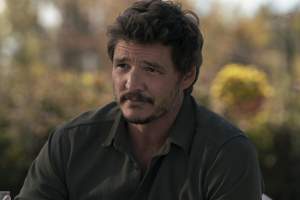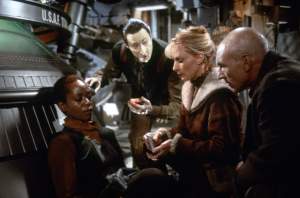Solyaris

classicman/moviestillsdb
Released in 1972, Solyaris was Russian filmmaker Andrei Tarkovsky’s answer to Stanley Kubrick’s 2001: A Space Odyssey. One of the great examples of science fiction in the medium, it’s a slow and meditative film uninterested in innovative special effects or ground-breaking technology. It instead hyper-focuses on the interior lives of its characters and explores themes such as the nature of life and death, childhood, nostalgia, and the fluidity of memory.
It is a challenging film — but one that will stick with you long after you’ve reached the end of its 166-minute runtime. Just a stunning, superlative example of Soviet-era cinema.
Hoop Dreams

Steve Kagan/Getty Images
Hoop Dreams is unquestionably one of the greatest documentaries ever made. Do not balk at the nearly three-hour run-time — it flies by as you get engrossed in the lives of the two African American boys at the center of the story.
Ostensibly about high-level high school basketball in the 90s and the hopes and dreams of the two central characters, the movie is an unflinching examination of issues of culture, class, race, and the American education system. The time, effort, and love put into this film by director Steve James and his team is staggering to think even about.
Network

barney112/moviestillsdb
Network, about the on and off-camera drama at a fictional cable news network, is a masterpiece satire about the effects of television on the American psyche. Paddy Chayefky’s screenplay is among the greatest ever written, and there are at least three monologues in the film that would easily rate among the greatest in cinema history.
The only flaw is that the film was so prophetic that some of the satire may fail to work for modern audiences since what was meant to be seen as ridiculous or unthinkable in the mid-1970s is just the normal state of 24 cable news in 2024.
Casablanca

Smooth5/moviestillsdb
The problem with recommending “old” movies to modern audiences is the perception that anything made before some arbitrary cutoff year is too slow or boring or dated. Casablanca is proof that this just isn’t the case. Released in 1942, the movie has the electric energy and passion of any movie released this year.
Casablanca is additionally interesting because it is a film about people living through and affected by World War II that was filmed when it was happening. As we get further away from real moments in history, it becomes increasingly valuable to be able to watch media that was created contemporaneously with the event.
Lady Bird

yassi/moviestillsdb
What an incredible debut effort from writer and director Greta Gerwig. Released in 2017, this film pulled off the impossible trick of figuring out a way to make the well-tread world of the coming-of-age story feel completely fresh again. The story is simultaneously broadly universal and deeply specific to her personal experience.
There’s not a performance to be found. Saoirse Ronan effortlessly holds her own as the emotional center of the narrative. Laurie Metcalf and Tracy Letts as her mother and father are devastating and raw. Even Timothée Chalamet is at his drippiest best as one of Lady Bird’s evolving coterie of crushes.
American Movie

Demon/MovieStillsDb
The second documentary on this list, director Chris Smith’s American Movie is the best film ever made about making movies. It is also the best film ever made about how we define success and failure and what happens when ambition is eclipsed by talent. Oh, and it also might be the best film ever made about life in the Midwest. We follow the trials and tribulations of Mark Borchardt as he struggles to produce an independent film with the help of his put-upon friends and family. It’s very funny yet also quite sad, and for anyone chasing a dream, it can be a deeply humbling experience.
The Seventh Seal

demon/moviestillsdb
You’ve probably seen images from or references to The Seventh Seal even if you’ve never seen or heard of the film before. Maybe in an episode of Family Guy, or movies like Bill & Ted’s Bogus Journey or The Last Action Hero. Death is a pleasant, white-faced man in a dark cloak, a weary knight challenging Death to a game of chess, the final scene depicts the Danse Macabre on a distant hillside. Released in 1957, this is a historical fantasy story set during the time of the Black Death and directed by legendary Swedish filmmaker Ingmar Bergman. It is a timeless, beautiful film about faith, duty, death, and much, much more.
Taxi Driver

74 kb/moviestillsdb
Like Network, the themes and observations explored by Martin Scorcese’s Taxi Driver have only become more relevant today than they were when the film was produced in the 1970s. There are obvious parallels to draw between Robert De Niro’s Travis Bickle and a certain kind of disaffected young man we often hear about today. It’s the individual obsessed with the filth and decay of the city, isolated and misanthropic, unsure where to put their growing rage. The bloody finale is just as shocking today, even if modern audiences have become desensitized to violence and gore. There’s something deeply unsettling in the way Scorcese frames the entire scene, particularly after every scene that precedes it.
Dr. Strangelove

zsolt/moviestillsdb
Dr. Strangelove was released in 1964, at a time when total nuclear war felt like a very real threat to civilization. There was little any normal person could do other than carry on with their lives. Perhaps it was the inherent tension and absurdity of that situation that inspired director Stanley Kubrick to create this landmark Cold War political satire. The film is wildly funny, owing mostly to the deadpan insanity of George C. Scott’s General Turgidson and the triple thread performance from Peter Sellers. Kubrick naturally also packs several unforgettable visuals in the movie, including the final image of a cowboy pilot riding his payload into oblivion.
The Texas Chain Saw Massacre

mrjackforrester/moviestillsdb
We’re of course talking about the original 1974 Tobe Hooper production and not the many sequels and remakes that that landmark horror film spawned (though TTCM 2 is charming in its own quirky way).
This is a powerful, deeply upsetting film with scenes that will assault your senses and leave you emotionally drained. Funny enough, it accomplishes all of this without showing an excessive amount of blood, gore, or explicit violence. Rather, it is the suggestion of violence, the tension and menace of the scenes, and the upsetting tone that will leave you needing a cigarette or a stiff drink. It absolutely must be seen once, though it’s perhaps best viewed in the early part of the day so you’ll still have sunlight left to get out and walk this one off.







